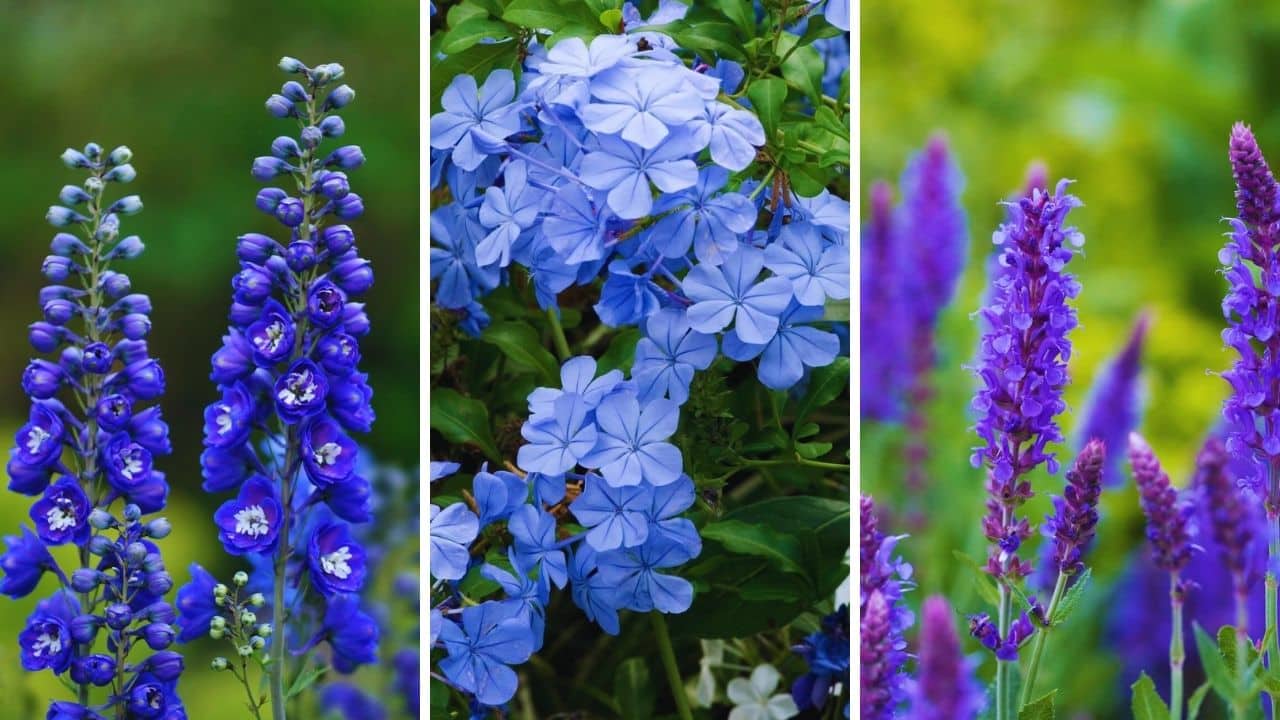Consider incorporating blue plants if you want to add a bright pop of color to your garden. Blue hues are visually appealing and can create a warm, welcoming, and creative environment in your garden.
According to Verywell Mind, blue is often described as peaceful, tranquil, secure, and orderly, making it a perfect addition to any garden for peace and serenity.
Here are ten blue plants to consider if you want to bring some calm and calming shades into your garden.
1. Delphinium
Delphinium is a striking plant known for its tall, cone-shaped flowers that add drama and intrigue to any garden. These flowers are perfect for attracting bees, butterflies, and hummingbirds, making them an excellent choice for creating a lively and vibrant backyard oasis.
Delphiniums thrive in full sun and well-drained soil and come in various shades of blue, from light sky blue to deep indigo.
Their tall stature and vivid colors make them a standout feature in any garden landscape, providing height and a burst of color that draws the eye and complements other garden plants beautifully.
2. Plumbago
Plumbago, with its gorgeous powder-blue flowers, is a plant that loves the heat and blooms continuously throughout the year in warmer climates. Despite its delicate appearance, it is hardy and can withstand high temperatures.
Plumbago is an excellent choice for adding a splash of blue to your garden, and its ability to bloom year-round makes it a favorite among gardeners looking for continuous color.
This plant also has relatively low maintenance, making it a practical and beautiful addition to any garden. Its sprawling growth habit perfectly covers large areas or cascades over garden walls.
3. Evolvulus
Evolvulus, also known as dwarf morning glory, is a sun-loving annual that adds a bright pop of blue to ground borders, hanging baskets, and container gardens. This plant is a showstopper with its vivid blue flowers that bloom throughout the summer.
Evolvulus is a low-growing plant that spreads across the ground, perfect for covering bare spots in the garden. It thrives in full sun and well-drained soil, and its vibrant color and easy care make it a popular choice for summer gardens. The plant’s compact size and prolific blooming make it a versatile addition to any garden design.
4. Salvia
Salvia is a versatile plant with many types, from annuals to perennials and shrub varieties. Known for their long-lasting blooms and ease of care, salvias are rock solid in the landscape and provide season-long color.
They are beautiful to pollinators like bees and hummingbirds. Salvias come in various blue shades, and their spiky flowers add height and texture to garden beds and borders.
They thrive in full sun and well-drained soil, making them a reliable choice for any garden. Their drought tolerance and minimal care requirements make them ideal for low-maintenance landscapes.
5. Hydrangea
Hydrangeas are a long-time garden favorite, known for their flashy, eye-catching blooms. These flowers come in various forms, from patio trees to small shrubs, and they bloom from spring to summer.
Hydrangeas are beloved for their large, mophead flowers that can change color based on the soil’s pH level. Blue hydrangeas require acidic soil to maintain their color, and they thrive in partial shade and well-drained soil.
Their lush, vibrant blooms make them a focal point in any garden. These plants are also known for their long-lasting flowers, which can stay vibrant for weeks, adding continuous beauty to your garden.
6. Muscari ‘Valerie Finnis’
Muscari ‘Valerie Finnis’ is a small, hardy bulb with spikes of robin’s egg-blue flowers. This plant is also deer-resistant, making it an excellent choice for gardens frequented by wildlife.
Muscari blooms in early spring and is often used in borders and rock gardens. Its compact size and vibrant blue color make it a delightful addition to any garden, and its ability to naturalize means it will return year after year.
Muscari thrives in full sun to partial shade and well-drained soil, adding a touch of early spring color that complements other spring-blooming plants.
7. Amsonia hubristic
Commonly known as thread-leaf blue star, Amsonia hubrictii is an herbaceous perennial with sky-blue star-like flowers and fine-textured leaves. This plant is also deer-resistant and adds a soft, airy texture to garden beds and borders.
Amsonia blooms in late spring to early summer and prefers full sun to partial shade and well-drained soil. Its unique foliage turns a bright golden yellow in the fall, providing multi-season interest.
Amsonia is an excellent choice for adding subtle blue hues to your garden, and its hardy nature makes it a reliable perennial that will thrive with minimal care.
8. Hosta ‘Blue Umbrellas’
Hosta ‘Blue Umbrellas’ boasts bold blue leaves with a seersucker-like surface and is excellent for shade. This plant adds texture and color to shady garden areas, and its large leaves create a dramatic effect.
Hostas are known for their lush foliage and are often used as ground cover or in shaded borders. They thrive in partial to full shade and moist, well-drained soil.
Hosta ‘Blue Umbrellas’ is a standout variety that adds a cool, calming blue to any shady garden spot, making it an excellent choice for creating lush, serene garden areas.
9. Nepeta ‘Prelude Blue’ Catmint
Nepeta’s Prelude Blue Catmint is a favorite among gardeners with its heavenly blue hue. It is very drought-tolerant and perfect for sunny spots in the garden. Catmint blooms from late spring to early fall, providing a long season of color.
It is also attractive to pollinators, making it a great addition to wildlife-friendly gardens. Nepeta thrives in full sun and well-drained soil, and its fragrant foliage adds another layer of interest.
This plant’s low maintenance and hardiness make it an excellent choice for any garden, particularly in areas that experience hot, dry conditions.
10. ‘Blue By You’ Salvia
‘Blue By You’ Salvia is a new favorite blue-hue plant that blooms for several weeks in the garden. The flowers are a striking blueish-purple and look stunning against the green foliage. This salvia is known for its long bloom time and ease of care.
It thrives in full sun and well-drained soil and is resistant to pests and diseases. ‘Blue By You’ Salvia is a perfect choice for adding continuous color to garden beds and borders, and its vibrant flowers attract bees and butterflies, enhancing the biodiversity of your garden.
11. Virginia Bluebells
Virginia Bluebells (Mertensia virginica) are a delightful addition to any garden, known for their bright pink buds that open into delicate sky-blue bells.
This spring-blooming native wildflower naturalizes easily and goes dormant in summer, but it returns with vigor in spring. Virginia Bluebells thrive in filtered shade and moist, well-drained soil, making them ideal for woodland gardens.
Their early bloom time provides much-needed color after the winter months, and they attract early pollinators. The plant’s ephemeral nature means it won’t take up space all season, allowing other perennials to shine once dormant.
12. Love-in-a-Mist
Love-in-a-Mist (Nigella Damascena) is a classic cottage garden flower known for its delicate, ferny foliage and ornamental seedpods. This annual plant blooms in spring through early summer, producing sky-blue flowers that add a whimsical touch to the garden.
Love-in-a-Mist thrives in full sun and well-drained soil. Its intricate flowers and unique seedpods make it a favorite for fresh and dried cut-flower arrangements.
The plant is also easy to grow from seed, making it an excellent choice for novice gardeners looking to add a splash of blue to their garden.
13. Brunnera ‘Jack Frost’
Brunnera ‘Jack Frost,’ also known as Siberian Bugloss or heartleaf brunnera, is a shade-loving perennial prized for its lovely sprays of tiny baby-blue flowers and striking silver foliage with green veins.
This plant blooms in late April to June, providing early-season color. Brunnera thrives in shade, partial sun, and moist, well-drained soil. Its foliage remains attractive throughout the growing season, adding texture and interest to shady garden spots.
Brunnera ‘Jack Frost’ is also deer-resistant, making it a practical choice for gardens frequented by wildlife.
14. Globe Thistle
Globe Thistle (Echinops spp.) is a unique plant with spiky, golfball-sized flower heads that make a bold statement in the garden. The blue blooms, which resemble ornamental onions, appear in late June and continue through September.
Globe Thistle thrives in full sun and well-drained soil, and its rugged, drought-tolerant nature makes it ideal for low-maintenance gardens. The plant’s striking flowers attract bees and butterflies, adding to its appeal.
Globe Thistle’s unusual shape and vibrant color make it a standout feature in any garden, providing visual interest and texture.
15. Bluebeard
Bluebeard (Caryopteris x clandonensis) is a compact shrub that produces an abundance of deep-blue flowers late into the season. The clusters of fragrant flowers attract butterflies and other pollinators, making it a valuable addition to wildlife-friendly gardens.
Bluebeard blooms from midsummer through fall, providing continuous color when many other plants have finished blooming. This shrub thrives in full sun and well-drained soil and is relatively drought-tolerant once established.
Bluebeard’s vibrant flowers and easy care make it a versatile and attractive choice for adding blue hues to your garden.
Summary
Adding blue plants can create a serene and visually stunning landscape. From the tall, dramatic Delphinium to the low-growing, vibrant Evolvulus, these blue plants offer a range of options for gardeners looking to enhance their outdoor spaces.
Each of these plants brings unique charm and color, ensuring your garden will be a beautiful and calming retreat. Whether you prefer sun-loving annuals or shade-tolerant perennials, a blue plant suits every garden and gardener’s taste. Embrace the tranquility and beauty of blue blooms to transform your garden into a haven of peace and visual delight.







































